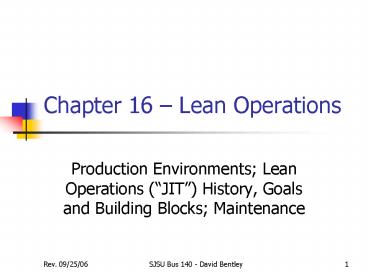Chapter 16 Lean Operations PowerPoint PPT Presentation
1 / 19
Title: Chapter 16 Lean Operations
1
Chapter 16 Lean Operations
- Production Environments Lean Operations (JIT)
History, Goals and Building Blocks Maintenance
2
Part 2 Summary to Date - 1
- Forecasting demand is basis for all planning
- Approaches
- Judgment
- Associative (for cycles)
- Historical
- Multi-period pattern (for trend and seasonal)
- Single period patternless (other)
- Measures of forecast error
3
Part 2 Summary to Date - 2
- Aggregate planning
- Sales plan
- Production plan (most likely in )
- Long range resource plan (LRRP)
- Disaggregate to intermediate range
- Demand forecast (include other demand)
- Master production schedule (MPS)
- units of product (or end items)
- Rough cut capacity plan (RCCP)
- Only resources critical to meeting the MPS
4
Part 2 Summary to Date - 3
- MPS drives the next level
- Material Requirements Plan (MRP)
- All assemblies, subassemblies, fabricated parts,
components, raw material - Predicts shortages
- Suggests action through messages
- Capacity Requirements Plan (CRP)
- All labor, equipment, other important resources
5
Part 2 Summary to Date - 4
- MRP terms
- Gross requirements
- Derived from planned order releases at higher
level - Scheduled receipts
- Date and quantity for delivery of existing orders
- Projected availability
- Starts with current on hand
- If negative net requirements, MRP must plan
action - Planned order releases
- Created by MRP, dont exist outside the computer
6
Part 2 Summary to Date - 5
- MRP processing
- Driven by MPS
- Proceeds level by level
- Projects available inventory until shortage
- Then suggests push, pull, cancel
- If not adequate, creates planned order
- Order quantity determined by lot sizing rule
- Order release date determined by lead time
7
Part 2 Summary to Date - 6
- Evolution of MRP Systems
- MRP (Joseph Orlicky)
- Closed Loop MRP (Oliver Wight)
- MRP II (Oliver Wight)
- ERP (Gartner Group)
- Latest hot buttons
- Supply chain management
- E-commerce
8
Production Environments
- Product Characteristics (continuum)
- Customized lt--------------gt Commodity
- Operation Types (continuum)
- Project
- Job Shop
- Batch
- Repetitive/Assembly
- Continuous flow __
9
History of Lean Operations (JIT)
- Japanese Post-WW II conditions
- Emphasis on quality and eliminating waste
- Also called lean manufacturing or the Toyota
production system - U.S. attention as a result of oil embargo
- Change in philosophy needed in U.S.
- Also called Zero Inventory in U.S.
10
Obstacles to JIT in the US
- Emphasis on MRP systems
- Fit job shops most closely
- APICS, Oliver Wight and others
- Cost Accounting
- Traditional job accounting
- Management
- Reluctance to empower employees
- Focus on high utilization
- Limited allowance for training
11
Key Contributors to JIT - 1
- Japan (developer)
- Taichi Ohno (Toyota Motor Company)
- Toyota Production System
- Aka Lean Production or Lean Manufacturing
12
Key Contributors to JIT - 2
- US (popularizers)
- Richard Schonberger (U of Nebraska, U of
Washington) - Emphasized concepts, management aspect
- Japanese Manufacturing Techniques
- World Class Manufacturing
- Robert Hall (U of Indiana)
- Emphasized specific tools and techniques
- Zero Inventories
13
Lean Operations Goals
- Eliminate waste
- Smooth the flow
- Minimize disruptions
- Minimize inventory
- Reduce queue, setup, wait, transit times
- Reduce lead time
- Introduce flexibility
- Reduce cost
14
Lean Operations Requirements
- Management commitment
- Quality
- Training
- Worker involvement / ownership
- Flexibility - people and equipment
- Process changes
- Supplier partnerships
15
Building Blocks - 1
- Product design
- Standard parts
- Modular design
- Capable production systems
16
Building Blocks - 2
- Process design
- Quality improvement
- Small lot sizes
- Setup time reduction
- Manufacturing cells
- Limited WIP
- Production flexibility
- Minimal inventory storage
17
Building Blocks - 3
- People
- View employees as assets
- Cross-training
- Commitment to continuous improvement
- Cost accounting (big obstacle in U.S. due to job
costing bias) - Leadership
18
Building Blocks - 4
- Manufacturing planning and control
- Level loading
- Pull systems
- Visual signals (Kanban)
- Container, card(s), cart, taped space on floor or
counter, colored lights (??), golf balls (??) - Supplier partnerships
- Reduced transaction processing
- Preventive maintenance and housekeeping
19
Making the change
- Insure true management commitment
- Provide employees training
- Focus on internal operations before moving on to
suppliers - Start small (one line) and at end of process
- Deal with cost accounting issues early
- Now extend to your suppliers

